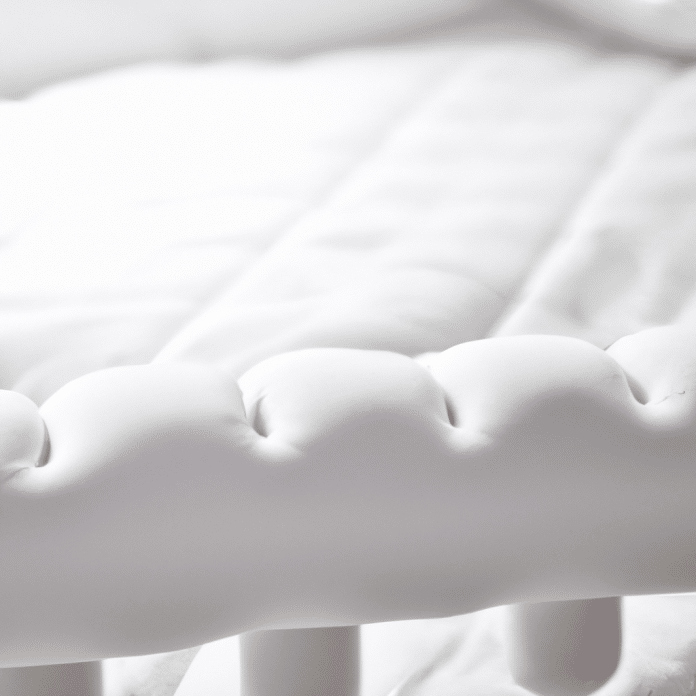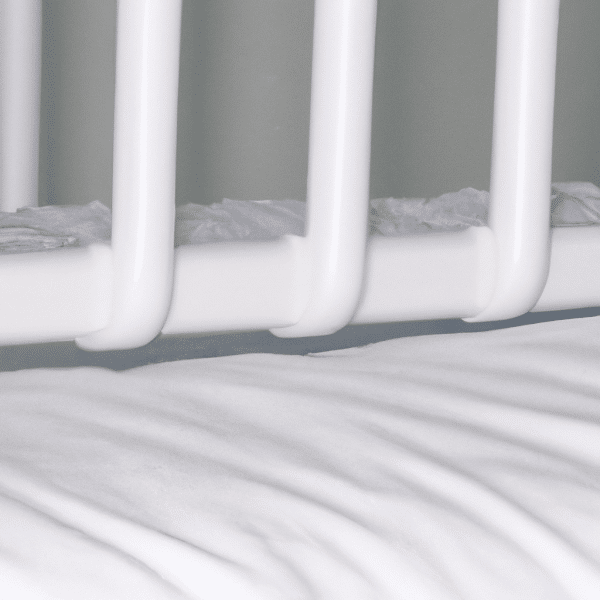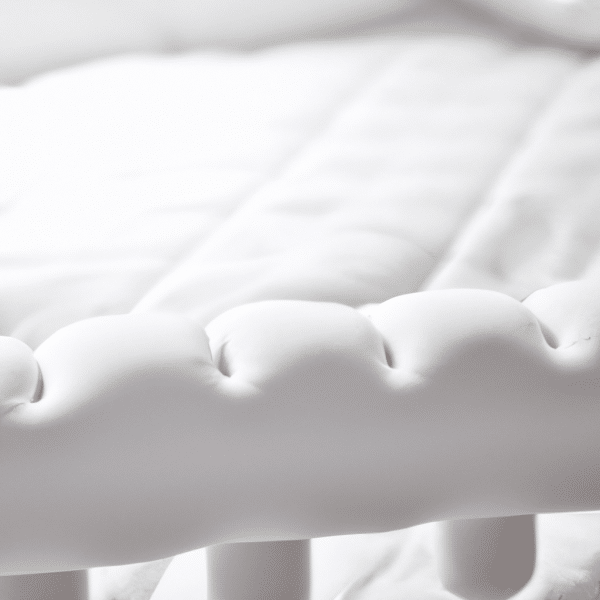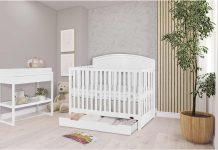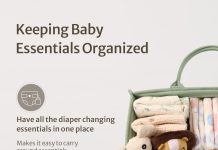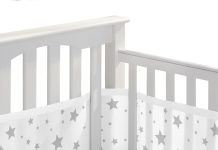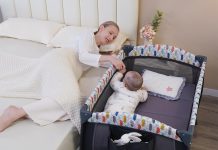Let’s talk crib bumpers! As parents, we all want to create a safe and cozy environment for our little ones. However, when it comes to crib bumpers, there seems to be a lot of confusion about what’s safe and what’s not. In this article, we’ll unravel the mystery and discuss the rules and guidelines surrounding crib bumpers for the safety of our precious babies.
Review contents
The Purpose of Crib Bumpers
Understanding the Function of Crib Bumpers
Crib bumpers, also known as crib liners, are padded sheets that surround the interior perimeter of a baby’s crib. They are commonly used to prevent the baby from getting their limbs stuck between the crib slats or bumping their head against the hard crib rails. In addition to providing a cushioning effect, crib bumpers are also used to create an aesthetically pleasing and cozy environment for the baby. Many parents opt for crib bumpers as they believe it enhances the overall appearance of the nursery and provides a sense of security for their little one.
Potential Risks Associated with Crib Bumpers
Despite their widespread use, crib bumpers have come under scrutiny in recent years due to potential safety risks they pose. Studies have indicated that crib bumpers can pose risks such as suffocation, strangulation, and restrict airflow. These concerns have led to increased awareness and debate surrounding the use of crib bumpers and prompted various organizations to issue guidelines and recommendations to ensure the safety of infants.
Regulations and Guidelines
Consumer Product Safety Commission (CPSC)
The Consumer Product Safety Commission (CPSC) is a federal agency in the United States responsible for protecting the public from unreasonable risks of injury or death associated with consumer products. The CPSC has recognized the potential hazards of crib bumpers and has issued safety standards and guidelines to address these concerns. They have advised against the use of traditional crib bumpers with cushioning and ties, as they pose suffocation and strangulation risks.
American Academy of Pediatrics (AAP)
The American Academy of Pediatrics (AAP) is a professional organization of pediatricians dedicated to the health and well-being of infants, children, adolescents, and young adults. The AAP has recommended against the use of crib bumpers in order to reduce the risk of suffocation, strangulation, and other hazards. They emphasize the importance of creating a safe sleep environment for infants, which includes avoiding the use of any loose bedding, including crib bumpers.
Safety Standards for Crib Bumpers
There are safety standards in place for crib bumpers to address the potential risks they may pose. The standards focus on ensuring that crib bumpers are designed and manufactured in a way that minimizes hazards. For instance, breathable mesh liners have been introduced as an alternative to traditional crib bumpers. These liners allow for better airflow and reduce the risk of suffocation. Additionally, crib rail covers are available to protect the baby from bumping their head against the hard crib rails, without the risks associated with traditional bumpers.
Recent Studies and Recommendations
Research on Crib Bumpers and Infant Safety
Recent studies have supported the concerns around crib bumpers, highlighting the potential dangers they pose to infants. One study published in the Journal of Pediatrics found that between 1990 and 2010, there were 48 infant deaths associated with crib bumpers in the United States. The study concluded that the risks of using crib bumpers outweigh any potential benefits, and recommended their elimination from the market.
Updated Recommendations from Experts
In light of the evidence and ongoing research, experts and organizations have updated their recommendations regarding crib bumpers. The AAP, in their updated guidelines, specifically advises against the use of crib bumpers, citing the potential risks of suffocation, strangulation, and other hazards. The CPSC has also reinforced their safety standards and guidelines, urging parents to create a safe sleep environment for their infants by following these recommendations. These updated recommendations aim to protect infants and reduce the risk of injury or death associated with crib bumpers.
Alternatives to Crib Bumpers
Breathable Mesh Liners
As an alternative to traditional crib bumpers, breathable mesh liners have gained popularity in recent years. These liners are made of breathable fabric that allows for adequate airflow while still providing a barrier between the baby and the crib slats. The mesh design reduces the risk of suffocation and prevents the baby’s limbs from getting caught between the slats. Breathable mesh liners offer a safer option for parents who prefer to have some form of padding in the crib without compromising the baby’s safety.
Crib Rail Covers
Another alternative to crib bumpers is the use of crib rail covers. These covers are designed to wrap around the top rails of the crib, providing a protective barrier between the baby’s head and the hard surface of the crib rails. Crib rail covers are typically made of soft, padded material that absorbs impact, reducing the risk of head injuries. They can be easily attached and removed from the crib, making them a convenient option for parents who want to minimize the risk of their baby bumping their head without using traditional crib bumpers.
Proper Mattress Positioning
In addition to alternative products, proper mattress positioning is crucial for maintaining a safe sleep environment for the baby. Ensuring that the crib mattress is correctly positioned can greatly reduce the risk of suffocation and airflow restriction. The mattress should be placed at the lowest level, allowing for optimal stability and minimizing the risk of the baby falling out of the crib. Additionally, ensuring a snug fit between the mattress and the crib sides prevents the baby from getting trapped between the mattress and the crib, reducing the risk of suffocation.
Risks and Dangers
Suffocation Hazards
One of the primary risks associated with crib bumpers is suffocation. Traditional bumpers with cushioning can pose a suffocation hazard if the baby rolls against them, potentially obstructing the baby’s airway. Infants lack the motor skills to free themselves from predicaments like this, increasing the risk of suffocation. Proper airflow is essential for safe sleep, and the use of crib bumpers can compromise this by obstructing the baby’s access to fresh air and increasing the risk of carbon dioxide buildup.
Strangulation Risks
Crib bumpers with ties or fasteners can also pose a strangulation risk. Babies may become entangled in the ties or ribbons attached to the bumpers, leading to accidental strangulation. This risk is particularly concerning for infants who are more mobile and able to grab onto objects within their reach. Infants can unintentionally wrap the ties or ribbons around their necks, restricting their airflow and causing injury or death. The presence of ties also increases the risk of accidental falls if the baby pulls on them and dislodges the bumper.
Airflow Restriction
Crib bumpers, especially those made of thick padding or non-breathable material, can restrict airflow within the crib. This can lead to overheating and increase the risk of Sudden Infant Death Syndrome (SIDS). Proper ventilation and breathability are crucial for maintaining a safe sleep environment for infants. The use of breathable materials, such as mesh liners or crib rail covers, can help ensure adequate airflow and reduce the risk of overheating.
Recommendations for Safe Use
Follow Manufacturer’s Guidelines
If parents choose to use crib bumpers, it is essential to follow the manufacturer’s guidelines and recommendations for installation and usage. Each bumper may have specific instructions that ensure optimal safety. Parents should carefully read and understand these guidelines and make sure they are properly attaching the bumpers to the crib. By following the manufacturer’s instructions, parents can minimize potential risks and ensure the safest possible use of crib bumpers.
Regularly Check for Loose or Damaged Bumpers
Regularly inspecting the condition of crib bumpers is crucial for maintaining a safe sleep environment. Parents should check for any signs of wear, tear, or damage, such as loose stitching or torn padding. If any issues are found, the bumpers should be replaced immediately. Additionally, if the baby becomes more mobile and starts pulling on the bumpers, it may be necessary to remove them to prevent accidents. By regularly checking the condition of the bumpers, parents can promptly address any potential hazards and ensure their baby’s safety.
Maintain Optimal Sleep Environment
Creating an optimal sleep environment for infants is essential for their safety and well-being. Along with avoiding the use of crib bumpers, parents should follow other sleep safety recommendations. These include placing the baby on their back to sleep, using a firm and properly fitting crib mattress, keeping the crib free of loose bedding or toys, and ensuring a comfortable room temperature. By maintaining an ideal sleep environment, parents can help reduce the risk of accidents and promote safe sleep for their infants.
Legal Guidelines and Bans
Crib Bumper Bans in Certain States
In response to the safety concerns associated with crib bumpers, several states in the United States have implemented bans on the sale and manufacture of crib bumpers. These states include Maryland, Ohio, and Illinois. The introduction of these bans aims to protect infants from potential harm and reduce the availability of unsafe crib bumpers in the market. The bans also highlight the recognition by lawmakers and government bodies of the potential risks posed by crib bumpers and the necessity for stricter regulations.
Lobbying Efforts and Legal Actions
Alongside the bans, there have been lobbying efforts and legal actions aimed at raising awareness about the risks of crib bumpers and advocating for their removal from the market altogether. Various organizations and advocacy groups have been actively involved in these efforts, working to promote infant safety and urging parents to prioritize safe sleep practices. Through lobbying and legal actions, these groups aim to prevent further harm to infants and ensure that safer alternatives are widely available and accessible to parents.
Educational Campaigns
Promoting Awareness of Crib Bumper Risks
To address the concerns surrounding crib bumpers and educate parents about the potential risks, educational campaigns have been launched. These campaigns aim to spread awareness about the dangers of crib bumpers and provide information on safe sleep practices. Through various channels such as websites, social media, and partnerships with healthcare providers, these campaigns strive to reach a wide audience of parents and caregivers. By increasing awareness, these campaigns empower parents to make informed decisions and prioritize their baby’s safety.
Reaching Out to Parents and Caregivers
Educational campaigns also focus on reaching out to parents and caregivers directly through community initiatives and partnerships. These efforts include distributing educational materials, organizing workshops and seminars, and collaborating with healthcare professionals to provide accurate and up-to-date information. By engaging with parents and caregivers face-to-face, educational campaigns can address any concerns or misconceptions and promote safe sleep practices, thereby reducing the use of crib bumpers and minimizing the associated risks.
Concerns and Debates
Parental Perspectives on Crib Bumpers
The use of crib bumpers has elicited varying perspectives among parents. While some parents consider them to be an essential part of creating a cozy and secure environment for their baby, others have become more aware of the potential risks and opted to avoid their use altogether. Parental perspectives often reflect the balance between aesthetics and safety, with some parents willing to compromise safety for the appearance and overall feel of the nursery. However, as awareness grows and more information becomes available, many parents are choosing alternative products that provide a safer sleep environment without sacrificing aesthetics.
Arguments for and against Banning Crib Bumpers
The debate surrounding the banning of crib bumpers centers around several arguments. Those in favor of a ban emphasize the potential risks associated with crib bumpers, highlighting the evidence of suffocation, strangulation, and restricted airflow. They argue that the use of alternative products and adherence to safe sleep guidelines can sufficiently protect infants without the need for crib bumpers. On the other hand, opponents argue that a complete ban infringes on parents’ individual choices and may not significantly impact infant safety. They believe that educating parents about safe usage and promoting awareness is a more effective approach than imposing a ban.
Balancing Individual Choices and Safety Guidelines
Finding the balance between personal choices and safety guidelines is a challenge for both parents and policymakers. While parents have the right to make choices for their child’s nursery, it is essential to prioritize safety. Policymakers and regulatory bodies play a crucial role in setting safety standards and guidelines that protect infants from avoidable harm. By involving parents, healthcare professionals, and experts in the decision-making process, it is possible to strike a balance that respects individual choices while ensuring the highest level of safety for infants.
Conclusion
Crib bumpers have long been a popular choice among parents for their perceived benefits in terms of aesthetics and creating a cozy environment for infants. However, the potential risks associated with crib bumpers, including suffocation, strangulation, and restricted airflow, have prompted various organizations and regulatory bodies to issue guidelines and recommend against their use. Studies have provided evidence supporting these concerns, leading to updated recommendations and the introduction of safer alternatives such as breathable mesh liners and crib rail covers. The bans implemented by certain states and the efforts of educational campaigns highlight the increasing recognition of the potential dangers posed by crib bumpers and the importance of prioritizing infant safety. Ultimately, it is crucial for parents to be aware of the potential risks, make informed decisions, and create a safe sleep environment that ensures the well-being of their babies.

